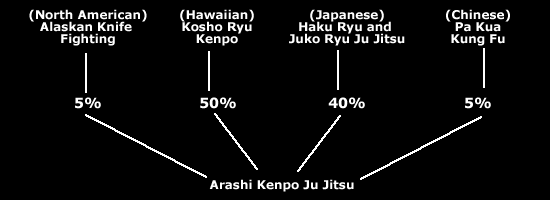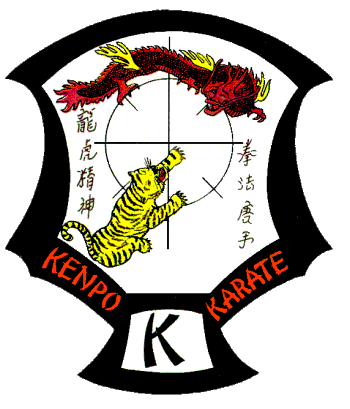Origins of Arashi Kenpo Ju Jitsu
Introduction
Arashi Kenpo Ju Jitsu is a self defense system focusing on the most effective and realistic martial arts skills needed in modern society. Kenpos goal is to tailor a training program to fit the needs of the individual according to their physical capabilities. Kenpo strives to identify all types of dangers confronting us and to practise a full spectrum of effective techniques and concepts that are easy to learn. Students are taught how to survive in self defense combat, how to control their emotions and to always think of how to resolve conflicts without physical violence.
It has its initial roots in the arts of Ju Jitsu, Kenpo,Pa Kua,Atemi jutsu and street fighting methods.There are no competitive aspects in arashi kenpo ju jitsu at all. The techniques are totally one hundred per cent designed for street confrontations. Students are trained from day one in effective and dynamic self preservation methods.
Systems adapted to make up Arashi Kenpo Ju Jitsu

The systems above are the basic component of the kenpo fighting system originally taught by Master W. Foulkes. These are not the only origins of Arashi Kenpo Ju Jitsu, the system is evolving all the time. Techniques from a wide range of sources are changed and adapted all the time, and incorporated into the Arashi Kenpo Ju Jitsu style.
For more details about the systems that make up Arashi Kenpo Ju Jitsu click here
THE KENPO CREST.

The Shape
The top of the crest is like a roof which gives shelter to all who come under it while the sides are curved conversely like the roof of a Chinese home to send back evil to where it came from. Look at the bottom of the crest and you will notice the shape of an axe. This represents an executioner, symbolising that should a member shame the Kenpo style or be influenced by evil ideas and thoughts contrary to the style's philosophy, he will be cut off - never to co-exist with members again.
The Tiger
Represents the earthly strength derived through the early stages of learning. This is the stage where the individual is more impressed with his own physical prowess.
The Dragon
Represents spiritual strength which comes with seasoning. This mental attitude is attained during the individual's latter years of training. It is placed above earthly strength - as seen on the patch - since the individual at this stage has learned to develop humility and self-restraint.
The Circle
This is symbolic of several things. It depicts life itself; a continuous cycle with no beginning or end just like the art of Kenpo which is also a cycle of unending and perpetual movement and motion. Techniques follow a cycle just as the various movements. Physical prowess, humility and self-restraint are no more than components of a progressive learning cycle. The circle is the base from which our alphabet stems; all moves evolve from a circle whether they are defensive or offensive. The circle also represents the bond of friendship that should continuously exist among association members.
The Oriental writing
This is a reminder of the originators of the art - the Chinese. It offers respect to them but doesn't denote that we serve them. The Chinese characters on the right say 'Law of the Fist and Empty hand' while the writing on the left - 'Spirit of the Dragon and the Tiger' - are a constant reminder that we should strive to attain a spiritual level and that the physical level is only a stepping Stone or vehicle to reach a higher, spiritual level.
The Dividing Lines
In the circle they represent the original 18 hand movements and directions in which the hands can travel. They are the angles from which you or an opponent can attack or defend, and they also form the pattern in which the feet can travel.
The 'K'
This stands for Kenpo.
The Colours
The white background is significant of the many beginners who form the base of the art. The yellow or orange represents the first level of proficiency - the mechanical, dangerous stage of learning. This is a time when the student it more impressed with the physical and thinks he knows all the answers. The circle is grey symbolising the brain, the brain of the association - remember that the brain it often referred to as 'grey matter'. The other colours represent proficiency, achievement and authority. Brown - the colour of the tiger's eyes - represent the advanced students though not great in number. Also at this level the student becomes more observant. His eyes, like that of the tiger, are keen and ever so watchful and critical, always looking up to the higher levels of proficiency; striving for perfection and preparing for the day he bears the label of 'expert'. This level of expert proficiency is represented by the colour black, while red is that of professorship over and above black belt. But yet, as indicated by the colours of the dragon, there are still traces white in the eyeball; yellow or orange on his fins; brown in the iris of the eyeball and black in the pupils. These colours are there to remind even the 'professor' that he should always be humble and able to return to any level. He should also be able to perform the things that he expects others at various levels to do and always be conscious of never demanding too much of his students.